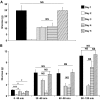The glucagonostatic and insulinotropic effects of glucagon-like peptide 1 contribute equally to its glucose-lowering action
- PMID: 20150286
- PMCID: PMC2889777
- DOI: 10.2337/db09-1414
The glucagonostatic and insulinotropic effects of glucagon-like peptide 1 contribute equally to its glucose-lowering action
Abstract
Objective: Glucagon-like peptide 1 (GLP-1) exerts beneficial antidiabetic actions via effects on pancreatic beta- and alpha-cells. Previous studies have focused on the improvements in beta-cell function, while the inhibition of alpha-cell secretion has received less attention. The aim of this research was to quantify the glucagonostatic contribution to the glucose-lowering effect of GLP-1 infusions in patients with type 2 diabetes.
Research design and methods: Ten male patients with well-regulated type 2 diabetes (A1C 6.9 +/- 0.8%, age 56 +/- 10 years, BMI 31 +/- 3 kg/m(2) [means +/- SD]) were subjected to five 120-min glucose clamps at fasting plasma glucose (FPG) levels. On day 1, GLP-1 was infused to stimulate endogenous insulin release and suppress endogenous glucagon. On days 2-5, pancreatic endocrine clamps were performed using somatostatin infusions of somatostatin and/or selective replacement of insulin and glucagon; day 2, GLP-1 plus basal insulin and glucagon (no glucagon suppression or insulin stimulation); day 3, basal insulin only (glucagon deficiency); day 4, basal glucagon and stimulated insulin; and day 5, stimulated insulin. The basal plasma glucagon levels were chosen to simulate portal glucagon levels.
Results: Peptide infusions produced the desired hormone levels. The amount of glucose required to clamp FPG was 24.5 +/- 4.1 (day 1), 0.3 +/- 0.2 (day 2), 10.6 +/- 1.1 (day 3), 11.5 +/- 2.7 (day 4), and 24.5 +/- 2.6 g (day 5) (day 2 was lower than days 3 and 4, which were both similar and lower than days 1 and 5).
Conclusions: We concluded that insulin stimulation (day 4) and glucagon inhibition (day 3) contribute equally to the effect of GLP-1 on glucose turnover in patients with type 2 diabetes, and these changes explain the glucose-lowering effect of GLP-1 (day 5 vs. day 1).
Figures


Comment in
-
Taking aim at islet hormones with GLP-1: is insulin or glucagon the better target?Diabetes. 2010 Jul;59(7):1572-4. doi: 10.2337/db10-0299. Diabetes. 2010. PMID: 20587800 Free PMC article. No abstract available.
References
-
- Creutzfeldt WO, Kleine N, Willms B, Orskov C, Holst JJ, Nauck MA: Glucagonostatic actions and reduction of fasting hyperglycemia by exogenous glucagon-like peptide I (7–36) amide in type I diabetic patients. Diabetes Care 1996;19:580–586 - PubMed
-
- de Heer J, Rasmussen C, Coy DH, Holst JJ: Glucagon-like peptide-1, but not glucose-dependent insulinotropic peptide, inhibits glucagon secretion via somatostatin (receptor subtype 2) in the perfused rat pancreas. Diabetologia 2008;51:2263–2270 - PubMed
-
- Hvidberg A, Nielsen MT, Hilsted J, Orskov C, Holst JJ: Effect of glucagon-like peptide-1 (proglucagon 78–107 amide) on hepatic glucose production in healthy man. Metabolism 1994;43:104–108 - PubMed
-
- Nauck MA, Kleine N, Orskov C, Holst JJ, Willms B, Creutzfeldt W: Normalization of fasting hyperglycaemia by exogenous glucagon-like peptide 1 (7–36 amide) in type 2 (non-insulin-dependent) diabetic patients. Diabetologia 1993;36:741–744 - PubMed
-
- Toft-Nielsen MB, Damholt MB, Madsbad S, Hilsted LM, Hughes TE, Michelsen BK, Holst JJ: Determinants of the impaired secretion of glucagon-like peptide-1 in type 2 diabetic patients. J Clin Endocrinol Metab 2001;86:3717–3723 - PubMed
MeSH terms
Substances
LinkOut - more resources
Full Text Sources
Other Literature Sources
Medical

